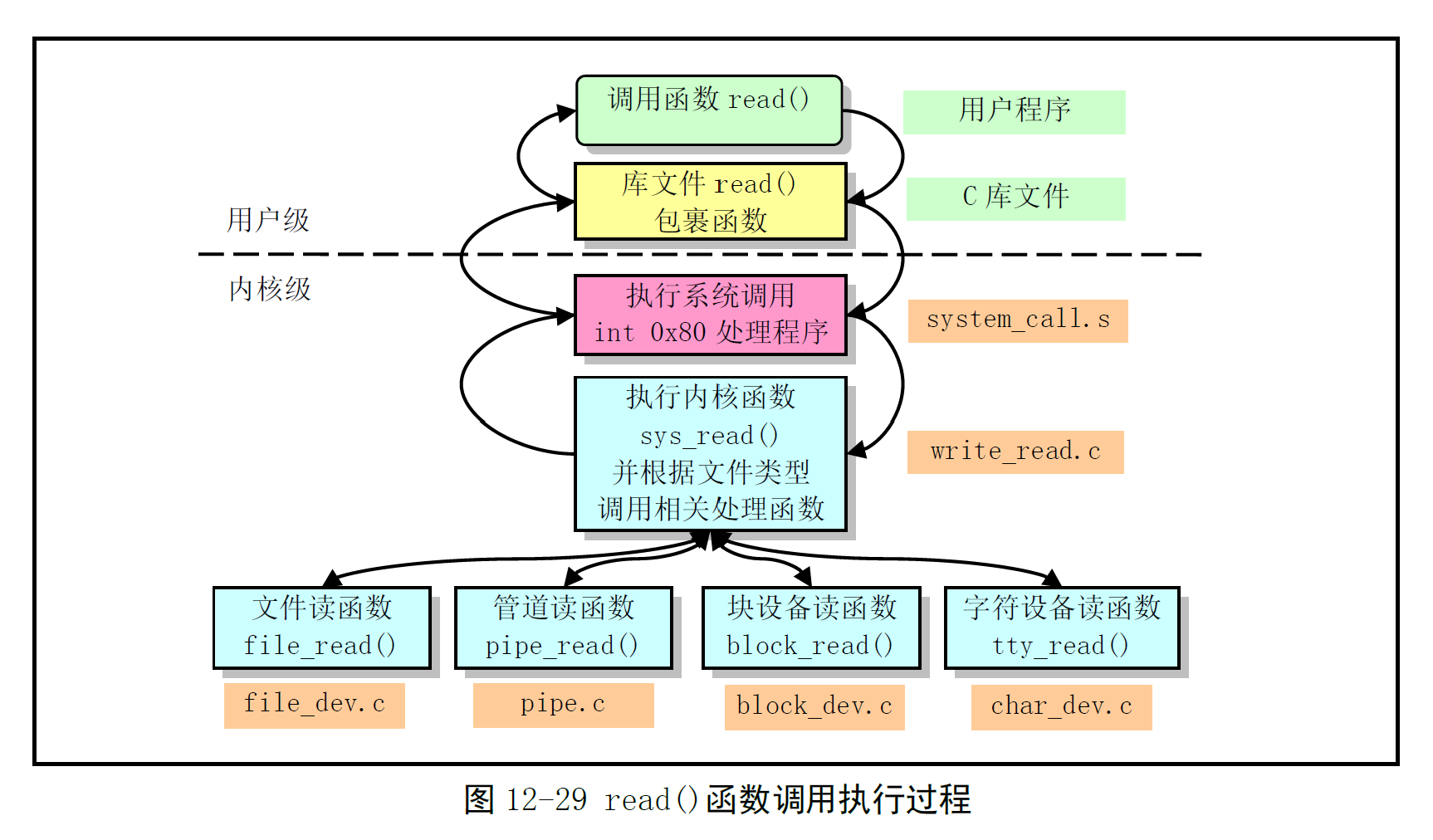Chapter 12.13 - read_write.c 程序
Created by : Mr Dk.
2019 / 09 / 18 15:37
Nanjing, Jiangsu, China
12.13 read_write.c 程序
12.13.1 功能描述
实现了文件操作的系统调用:
read()write()lseek():用于设置文件读写指针
read() 和 write() 是之前几个文件的上层接口。在这两个函数中,判断文件的类型,并调用对应的处理函数。
12.13.2 代码注释
定义在前几个文件中的各设备的读写操作函数
// 字符设备
extern int rw_char(int rw, int dev, char * buf, int count, off_t * pos);
// 管道设备
extern int read_pipe(struct m_inode * inode, char * buf, int count);
extern int write_pipe(struct m_inode * inode, char * buf, int count);
// 块设备
extern int block_read(int dev, off_t * pos, char * buf, int count);
extern int block_write(int dev, off_t * pos, char * buf, int count);
// 文件
extern int file_read(struct m_inode * inode, struct file * filp, char * buf, int count);
extern int file_write(struct m_inode * inode, struct file * filp, char * buf, int count);
sys_lseek() - 重定位读写指针系统调用
对于 origin 参数,表示偏移的起始位置,有三种选择:
SEEK_SET:0,从文件开始处SEEK_CUR:1,从文件当前位置SEEK_END:2,从文件末尾处
int sys_lseek(unsigned int fd, off_t offset, int origin)
{
struct file * file;
int tmp;
// 参数有效性判断
if (fd >= NR_OPEN || // 大于程序最多打开的文件数
!(file = current->filp[fd]) || // 该句柄的文件结构为空
!(file->f_inode) || // 文件对应的 inode 为空
!IS_SEEKABLE(MAJOR(file->f_inode->i_dev))) // 指针不可定位
return -EBADF;
if (file->f_inode->i_pipe) // 管道节点指针不可随意移动
return -ESPIPE;
switch(origin) {
case 0: // 指针位于文件开始处
if (offset < 0)
return -EINVAL;
file->f_pos = offset;
break;
case 1: // 指针位于当前读写指针的位置
if (file->f_pos + offset < 0)
return -EINVAL;
file->pos += offset;
case 2: // 指针位于当前文件末尾
if ((tmp = file->f_inode->i_size + offset) < 0)
return -EINVAL;
file->f_pos = tmp;
break;
default:
return -EINVAL;
}
return file->f_pos; // 返回重定位后的读写指针
}
sys_read() - 读文件系统调用
int sys_read(unsigned int fd, char * buf, int count)
{
struct file * file;
struct m_inode * inode;
// 参数有效性判断
if (fd >= NR_OPEN || // 超过程序最多打开文件数
count < 0 || // 需要读取的字节数小于 0
!(file = current->filp[fd])) // 句柄的文件结构指针为空
return -EINVAL;
if (!count)
return 0;
verify_area(buf, count); // 验证存放数据的缓冲区内存限制
inode = file->f_inode; // 取 inode
if (inode->i_pipe)
// 管道文件,且是读管道模式
return (file->f_mode & 1) ? read_pipe(inode, buf, count) : -EIO;
if (S_ISCHR(inode->i_mode))
// 字符型设备文件
return rw_char(READ, inode->i_zone[0], buf, count, &file->f_pos);
if (S_ISBLK(inode->i_mode))
// 块设备文件
return block_read(inode->i_zone[0], &file->f_pos, buf, count);
if (S_ISDIR(inode->i_mode) || S_ISREG(inode->i_mode)) {
// 目录或普通文件
if (count + file->f_pos > inode->i_size)
// 读取的字节数已经大于文件长度,则调整
count = inode->i_size - file->f_pos;
if (count <= 0)
// 读取的字节数小于等于 0
return 0;
return file_read(inode, file, buf, count);
}
// 执行到此处,则无法判断文件属性
printk("(Read)inode->i_mode=%06o\n\r", inode->i_mode);
return -EINVAL;
}
sys_write() - 写文件系统调用
int sys_write(unsigned int fd, char * buf, int count)
{
struct file * file;
struct m_inode * inode;
// 判断参数有效性
if (fd >= NR_OPEN || count < 0 || !(file = current->filp[fd]))
return -EINVAL;
if (!count)
return 0;
inode = file->f_inode; // 取文件的 inode
if (inode->i_pipe)
// 管道文件,且为写管道模式
return (file->f_mode & 2) ? write_pipe(inode, buf, count) : -EIO;
if (S_ISCHR(inode->i_mode))
// 字符设备文件
return rw_char(WRITE, inode->i_zone[0], buf, count, &file->f_pos);
if (S_ISBLK(inode->i_mode))
// 块设备文件
return block_write(inode->i_zone[0], &file->f_pos, buf, count);
if (S_ISREG(inode->i_mode))
// 常规文件
return file_write(inode, file, buf, count);
// 执行到这里,则无法判断文件属性
printk("(Write)inode->i_mode=%06o\n\r", inode->i_mode);
return -EINVAL;
}
12.13.3 用户程序读写操作过程
应用程序不直接调用 Linux 系统调用,而是调用封装了系统调用的库函数,以保证程序的可移植性。对于 Linux 系统,所有的 I/O 均通过读写文件的方式完成。在读写文件之前,需要打开文件,通知 OS 将要开始的动作:
- OS 将检查是否具有权限进行操作
- 如果 ok,OS 将会向程序返回一个文件描述符,替代文件名来确定访问的文件
- 此时,被打开的文件的信息由 OS 维护,用户通过文件描述符来访问文件
库函数中的 read 和 write:
int read(int fd, char * buf, int n);
int write(int fd, char * buf, int n);
库函数的具体实现:
#define __LIBRARY__
#include <unistd.h>
_syscall3(int, read, int, fd, char *, buf, off_t count)
其中 _syscall3 是一个宏,将被展开为:
int read(int fd, char * buf, off_t count)
{
long __res;
__asm__ volatile (
"int &0x80"
: "=a" (__res)
: "" (__NR_read), "b" ((long)(fd)), "c" ((long)(buf)), "d" ((long)(count))
);
if (__res >= 0)
return int __res;
errno = -__res;
return -1;
}
以 __NR_read (3) 为功能号,调用了 Linux 的系统调用中断。该中断在 eax 寄存器中返回了实际读取的字节数:如果返回的值小于 0,则表示此次读操作出错,对出错号进行取反,存入 errno 中,并返回 -1。整体函数的执行过程:
- 判断参数有效性
- 文件描述符大于系统最多同时打开的文件数 (20)
- 读取字节数小于 0
- 该文件还没有被打开 (文件结构项指针为 NULL)
- 验证存放数据的缓冲区大小是否合适,如果太小,系统会对其进行扩充 - 可能会冲毁后面的数据
- 获得该文件的 inode,根据其中的标志信息对文件类型进行判断
- 管道文件
- 字符设备文件:根据子设备号,调用字符设备驱动程序
- 块设备文件:调用内存高速缓冲处理程序 - 最后调用块设备驱动程序
- 常规文件:最后也会调用块设备驱动程序,但还需要维护内部文件表结构
- 返回,库函数
read()根据返回值来判断操作是否正确;若出错,则将错误号取反,并返回 -1
调用层次:
